
History 19th Indiana Infantry Regiment

|
.Ancestry of the
Frazee Family
Renville County
Minnesota
It had been known in the Frazee family
that we had a relative who served in the Civil War. Not much was
known about who he was and just exactly what he did in the Union Army.
Several years ago I was at the Vicksburg Battlefield and learned that
the National Park Service has a list of everyone who served in the
Civil War, Union or Confederae. On a chance that I might learn some-
thing about this relative I looked him up. I also looked up the name
of my Great Grandfather who was about the same age. I learned that the
mystery service member and my Great Grandfather were brothers and
they both served in the 100th Indiana Infantry. By using the internet
I have been able to learn a lot more about the Frazee brothers who
fought with the Union Army and this is what I learned.
Created by Bob Frazee
Copyright 2018, all rights reserved.
Updated: 5 Feb 2013; 2 Feb 2014, 7 April 2017, 23 May 2017, 24 March 2018 |
Isaac Newton Frazee's service in the
19th Indiana Infantry Regiment
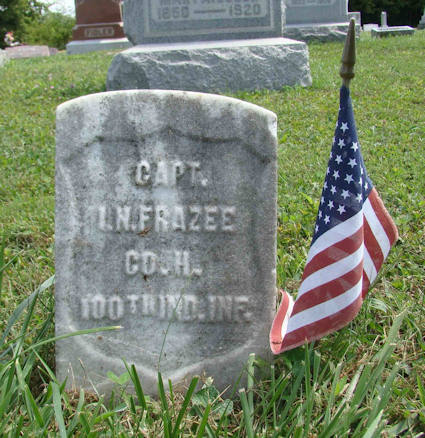
Antiock Cemetery,
Jay County, near Portland, Indiana
 Introduction:
My Great Grandfather Isaac Newton Frazee served in the Civil War. He initially enlisted in the Company C, 19th Indiana Infantry Regiment in July, 1861, and was promoted to Corporal before his discharge for disability. (date and disability unknown).
A year later he enlisted as the 1st Sergeant of Company H, 100th Indiana Infantry Regiment with his brother Abner J. Frazee. At the end of the Civil War Isaac was the Captain of Company H as reflected in the headstone above.
The 19th Indiana Infantry Regiment was assigned to the Army of the Potomic and fought in that theater of operations. It participated in the Second Battle of Bull Run, and the Battle of Gettysburg. After that battle the 19th had suffered so many casualties it was assigned to the 20th Indiana Infantry Regiment. The 20th has such a glorous Civil War history I just didn't want it lost or forgotten. The unit was with General Grant at Appomattox Courthouse when General Lee surrendered the Army of Virginia.
The 100th Indiana Infantry Regiment, where Isaac Newton and his brother Abner J Frazee fought the Civil War was attached to the Army of the Tennessee and fought with General Grant at the Seige of Vicksburg and Battle of Missionary Ridge and then was attached to General Sherman's Army as it marched to the sea. I have posted the full
History of the Frazee Family in the Civil War elsewhere.
 A Scottish Crest
"I am Prepared"
But I think we are
French Huguenots |
.Ancestry of the
Frazee Family
Renville County
Minnesota
This Frazee family history was originally
created by my father, Russel L. Frazee, in the
late 1950's. He was so proud of his work that he distributed copies to every member of the family. It was subsequently updated by my
brother, James R. Frazee. By using the
internet I have expanded upon the above information
by making some minor corrections and updating family
information by adding numerous photographs and census
data. I was particularly happy to find all the
information about the Frazee family in the Civil War.
It has made the search more interesting.
Created by Robert Frazee
Copyright 2018, all rights reserved.
Created: 28 March 2018 |

The Frazee Clan
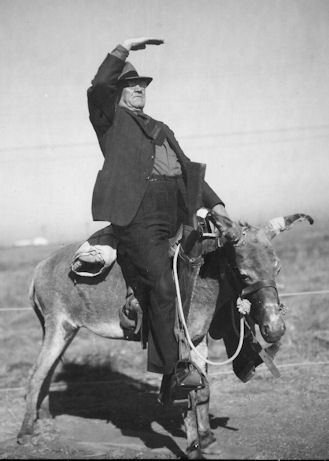
Oliver Sidney Frazee
aka: "The Boss" and "Grandpa"
Here Grandpa is on his way to visited
a brother in Arizona, 1951.
Some of Isaac's genes are in each of us.
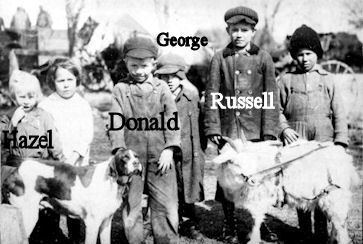
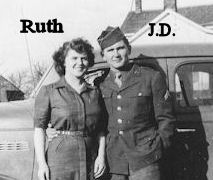
|
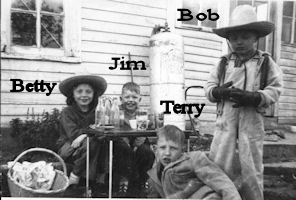
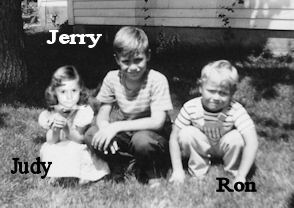
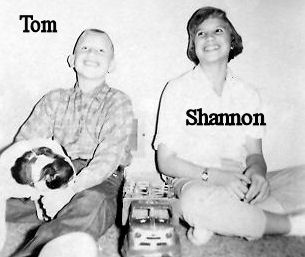

|


This Page is Under Construction so come back again.
28 March 2018 
[Web Master's Note: I obtained a copy of Grant's Memoirs of the Civil War, $0.99 on Kendle, and he describes
the details of his military campaigns starting from his attendance at West Point to the end of the
war. It is fascinating to note that Genereal Grant went to The Point, and then served in the army in
the war against Mexico, with many other West Point graduates, many of whom became Southern Generals,he
knew how they would respond in battle -- which ones would run, which ones would bluff and then retreat
and which ones would stand and fight. Another interesting thing is to learn that the Confederate Army was
never a cohesive unit -- each state had its own army which for the most part operated independently from
the other armys. It appears the only co-ordination was through Jefferson Davis, President of the Confederacy.
The Army of Virginia, led by General Robert E. Lee, was the target because it was the largest and led
by the best Generals.
Two very interesting books on the Civil war are: American Ulyssus: A Life of Ulyssus S. Grant,
by Ronald C. White, 2017, and William Tecumseh Sherman: In the Service of My Country, A Life, 2017,
by James Lee McDonough. These biographical books give the two Generals overall view of the war and mention the battles where Indiana's Company H, 100th Infantry Regiment was engaged. General Sherman turns out to be a real philosopher about the civil war and the events leading up to it.] 
Russell L. Frazee's Comments about the Civil War.
In the mid 1950's my father, Russell L. Frazee, Grandson of Isaac Newton Frazee, became interested in the Civil War but his research tools were limited (no internet back then) and it may have been sparked when he read several books by Bruce Catton, include Glory Road, This Hallowed Ground, and A Stillness at Appomattox, which are recommended readings. His books on the Civil Ware are very graphic and dramatic but I find nothing about the 19th Regiment Indiana Infantry or his Grandfather's role in it:
"Anyone interested in Civil War drama and the feelings and passions of the battlefield may find these works worth reading. The following information was gleaned from Bruce Catton's Mr. Lincoln's Army edited in 1954 and in whose book the famous Black Hat Brigade and its exploits are frequently referred to. This latter book is an interesting historical work about the Civil War as view through the Army of the Potomac, with all of its failures, misfortunes, and lack of leadership on the top level.
The 19th Indiana Volunteer Infantry was the pet regiment of Gov. Oliver P. Morton of Indiana. A sketch of the regiment's career is printed in "Indiana at Antietam," pp 107-123. The 19th Indiana, with the 2nd, 6th, and 7th Wisconsin Regiments, was assembled in Fredericksburg in the spring of 1862 and placed under the command of young John Gibbons. This outfit, the 19th Indiana, 2nd, 6th and 7th Wisconsin Regiments became known as the "Black Hat Brigade," which was to become famous throughout the remainder of the Civil War. The men of this outfit were outfitted, beyond regulations, with black felt hats and white gaiters/ hence their nickname, "The Black Hat Brigade." It served with valor in the army of the Potomac under McClellan, Hooker, and Meade, the army often referred to in Civil War history as "Mr. Lincoln 's Army." The Black Hat Brigade fought with distinction in the battles of Gainesville, Warrentown, South Mountain, Antietam, Second Battle of Bull Run, and the Battle of Gettysburg. It was at the battle of South Mountain that the Black Hat Brigade became known as the "Iron Brigade." The accepted story is that McClellan, watching its progress up the gap of South Mountain, had exclaimed in admiration: "That brigade must be made of iron!" Whatever its origin, the name stuck, and the brigade lived up to it valiantly the next summer at Gettysburg. See Gibbons Personal Recollections. 20th Indiana Volunteer Infantry." [Catton's book Stillness at Appomattix mentions the Iron Brigade in the Battle of Cold Harbor and Spottsylvania.]
Web Master's Note: (Robert Frazee, son of Russell L. Frazee and Great Grandson of Isaac Newton Frazee, Captain, Company H, 100 Regiment Indiana Infantry) It is interesting to note that my father appears to have known nothing about Isaac's discharge from the 19th Indiana Infantry Regiment and subsequent enlistment in the 100th Regiment Indiana Infantry. Oliver Frazee, Russell's father and my grandfather, the son of Isaac Newton Frazee, was about 38 years old when his father died and may not have discussed much about Isaac's experieneces in the Civil War. Some of those battles were so horrific and Isaac may not have talked about it, as is common of many returning combat soldiers. Isaac died before Russell was born and therefore Russell did not know his grandfather.
All of the history of Isaac's Civil War experience has been developed following my visit to the battlefield in Vicksburg, Mississippi, about 2015. There is a Monument to the Indiana units which served at Vicksburg but I had no knowledge that my Great Grandfather served in one of the units. I should go back and get a picture.
(Note: The following information about the 19th Indiana Volunteer Regiment is now available on-line from the National Park Service. This data was not available when the comments below by Bruce Catton were originally prepared in the late 1950's. Most of the following about the 19th Indiana Infantry Regiment is unrelated to Corporal Frazee's history because he was dischaged sometime before 28 Aug 1862 when he enlisted in the 100th Infantry Regement as a 1st Sergeant.)
Background:
Men enlisted into companies based upon the county they lived in. The Unit Roster for the 19th Regement Indiana Infantry lists Isaac Newton Frazee, a resident of Randolph County, as having enlisted on July 29, 1861. The record does not reflect what happened to him. See also: Company C, "Winchester Grays", 19th Regiment Indiana Infantry and Alphabetical List of Members of the 19th Regiment Indiana Infantry
National Park Service
History of the 19th Regiment, Indiana Infantry
Nineteenth Indiana Infantry. — Cols., Solomon Meredith, Samuel J. Williams, John M. Lindley; Lieut. -Cols., Robert A. Cameron, Alois O. Bachman, Samuel J. Williams, William W. Dudley, John M. Lindley; Majs., Alois O. Bachman, Isaac M. May, William W. Dudley, John M. Lindley, William Orr. This regiment was organized and mustered in at Indianapolis July 29, 1861. On Aug. 9 it joined the Army of the Potomac at Washington. Its first engagement was at Lewinsville, Va., Sept. 11, where it lost 3 men killed and wounded and 3 missing. It next fought at Falls church, after which it went into quarters at Fort Craig, near Washington. On March 10, 1862, it was attached to McDowell's (1st) Corps, with which it moved towards Fredericksburg and then toward the Shenandoah Valley. It remained at Warrenton until Aug. 5, 1862, when it made a reconnaissance towards Spottsylvania Court House.
[I am presuming that Corporal Frazee was discharged from the 19th Indiana Infantry Regiment before this time because he enlisted in the 100th Indiana Infantry Regiment on 28 Aug 1862. The 19th Indiana Infantry continued its military campaigns with the Army of the Potomac around Washington, D.C. While the 100th Indiana Infantry was assinged to the Army of Tennessee with General Grant.]
[The 19th Indiana Infantry Regiment] then joined Gen. Pope's Army, fought at Cedar mountain, Gainesville and the second Bull Run. At Gainesville it lost 187 in killed and wounded and 33 missing. After the second battle of Bull Run it was stationed for a time at Washington, then moved to Frederick City, Md., and when Lee began his invasion of Maryland moved with Hooker's corps in pursuit. At South mountain the regiment lost 40 in killed and wounded and 7 missing, and at Antietam went into action with 200 officers and men, of whom but 37 returned from the field. Col. Meredith was made a brigadier-general on Oct. 6, and Lieut. Col. Williams became colonel. At Fredericksburg the regiment was in the 4th brigade, 1st division, 1st corps, but was only slightly engaged. It then went into winter quarters until the beginning of Gen. Hooker's Chancellorsville campaign, when it was in an engagement at Fitzhugh's crossing of the Rappahannock, where it lost 4 men killed and wounded. It was in position at Chancellorsville, but was not called into action. It was then attached to the 1st brigade, 1st division, 1st corps, which was the first of the infantry to engage the enemy at Gettysburg on July 1, 1863. The regiment aided in the capture of Archer's Confederate brigade, but lost 210 men out of 288 that went into battle on that first day. During the other two days of the fight it occupied a position on Cemetery hill, but was not seriously engaged. It then took part in the Mine Run campaign and passed the winter near Culpeper, where a portion of the regiment reenlisted. It broke camp at the beginning of the Wilderness campaign; was engaged at the Wilderness, Laurel hill, about Spottsylvania, at the North Anna river and Cold Harbor; and was then constantly on duty in the trenches before Petersburg until the end of the siege. Its losses from May 4 to July 30, 1864, were 36 killed, 168 wounded and 16 missing. The non- veterans were mustered out at Indianapolis early in Aug., 1864, and the veterans and recruits as part of the "Iron brigade" took part in the expedition against the Weldon railroad. On Oct. 18, 1864, the regiment was consolidated with the 20th Ind., Col. Orr of the 19th becoming colonel of the new organization, and served thus until mustered out at Louisville, Ky., July 12, 1865.
The National Park Service says this about the 19th Regiment Indiana Infantry:
[Units to which it was assinged over the course of the Civil War] Organized at Indianapolis, Ind., and mustered in July 29, 1861. Left State for Washington, D. C., August 5. Attached to 3rd Brigade, McDowell's Division, Army of the Potomac, to March, 1862. 1st Brigade, King's 3rd Division, 1st Army Corps, Army of the Potomac, to April, 1862. 3rd Brigade, King's Division, Dept. of the Rappahannock, to June, 1862. 4th Brigade, 1st Division, 3rd Army Corps, Army of Virginia, to September, 1862. 4th Brigade, Iron Brigade, 1st Division, 1st Army Corps, Army of the Potomac, to June, 1863. 1st Brigade, 1st Division, 1st Army Corps, to March, 1864. 1st Brigade, 4th Division, 5th Army Corps, to August, 1864. 3rd Brigade, 3rd Division, 5th Army Corps, to September, 1864. 1st Brigade, 3rd Division, 5th Army Corps to October.
Battle of Lewinsville, Va., September 11, 1861. Reconnoissance to Lewinsville September 25. Occupation of Falls Church September 28. Duty at Fort Craig, Va., till March, 1862. Advance on Manassas, Va., March 10-16. Camp at Upton's Hill till April 9. Advance on Falmouth, Va., April 9-19. Duty at Falmouth and Fredericksburg till May 25. McDowell's advance on Richmond May 25-29. Operations against Jackson June 1-21. At Warrenton till August 5. Reconnoissance to Orange Court House July 24-27. Reconnoissance to Frederick's Hall Station and Spottsylvania Court House August 5-8. Thornburg's Mills August 5-6. Pope's Campaign in Northern Virginia August 16-September 2. Fords of the Rappahannock August 21-23. Sulphur Springs August 26. Gainesville August 28. Groveton August 29. Bull Run August 30. Maryland Campaign September 6-22. Battle of South Mountain September 14. Battle of Antietam September 16-17. At Sharpsburg till October 30. Movement to Warrenton, thence to the Rappahannock October 30-November 19. Battle of Fredericksburg, Va., December 12-15. Burnside's 2nd Campaign ("Mud March,") January 20-24, 1863. Duty at Falmouth till April. Chancellorsville Campaign April 27-May 6. Operations at Pollock's Mill Creek April 29-May 2. Fitzhugh's Crossing April 29-30. Battle of Chancellorsville May 2-5. Expedition to Westmoreland County and operations on Northern Neck May 20-26. Gettysburg (Pa.) Campaign June 11-July 24. Battle of Gettysburg July 1-3. Pursuit of Lee to Manassas Gap July 5-24. At Rappahannock Station and Culpeper August 1 to October. Bristoe Campaign October 9-22. Advance to line of the Rappahannock November 7-8. Mine Run Campaign November 26-December 2. Demonstration on the Rapidan February 6-7, 1864. Campaign from the Rapidan to the James River May 4-June 15. Battles of the Wilderness May 5-7; Laurel Hill May 8. Spottsylvania May 8-12. Spottsylvania Court House May 12-21. Assault on the Salient May 12. North Anna River May 23-26. Jericho Ford May 23. On line of the Pamunkey May 26-29. Totopotomoy May 28-31. Cold Harbor June 1-12. Bethesda Church June 1-3. Bottom's Bridge June 12. Before Petersburg June 16-18. Siege of Petersburg June 16 to October 18. Non-Veterans mustered out July 28, 1864. Weldon R. R. August 18-21. Consolidated with 20th Indiana Infantry October 18, 1864.
Regiment lost during service 5 Officers and 194 Enlisted men killed and mortally wounded and 1 Officer and 116 Enlisted men by disease. Total 316.
In (August)the late summer of 1864 THE 19TH Indiana had lost so many men from combat casualties, disease and the muster out of the non-veterans it was molded into the ranks of the 20th Indiana Infantry.
SPECIAL ORDERS NUMBER 317 DATED SEPTEMBER 23, 1864 SAID:
"UPON THE RECEIPT OF THIS ORDER BY THE COMMANDING GENERAL, ARMY OF THE POTOMAC, THE REENLISTED VETERANS AND RECRUITS OF THE 7TH AND 19TH INDIANA VOLUNTEERS, NOW REMAINING IN SERVICE, WILL BE PERMANENTLY TRANSFERRED TO THE 20TH INDIANA VOLUNTEERS, THE CONSOLIDATED FORCE TO BEAR THE NAME OF THE LATTER REGIMENT"
BECAUSE THE SURVIVORS FROM THE 19TH INDIANA SERVED WITH THE MEN FROM THE 20TH INDIANA UNTIL THE CLOSE OF THE WAR THIS PROJECT IS DEDICATED TO THESE HOOSIERS. WHO FOUGHT ON MANY OF THE SAME BATTLEFIELDS AS THE OLD "IRON BRIGADE".
The Roster of the Reorganized 20th Regiment Indiana Infantry does not include Isaac Newton Frazee. I don't find any records indicating him being transferred out of the 19th Regiment Indiana Infantry.
Twentieth Indiana Infantry. — Cols., William L. Brown, John Van Valkenburg, John Wheeler, William C. L. Taylor, William Orr, Albert S. Andrews ; Lieut. -Cols., Charles D. Murray, Benjamin H. Smith, John Van Valkenburg, John Wheeler, James H. Shannon, William C. L. Taylor, George W. Meikel, Albert S. Andrews, John W. Shafer; Majs., Benjamin H. Smith, John Van Valkenburg, John Wheeler, George F. Dick, James H. Shannon, William C. L. Taylor, George W. Meikel, Erasmus C. Galbreath, William Orr, Joseph T. Ives, John W. Shafer, John W. Williams.
This regiment was organized at Lafayette in July 1861, and was mustered in at Indianapolis, July 22. It left the state on Aug. 2, being ordered to Cockeysville, Md., for railroad guard duty. It sailed for Hatteras inlet, N. C, Sept. 24, and was sent to north end of Hatteras bank, 40 miles from the fortifications, without transportation or artillery. It was attacked on Oct. 4, by the enemy's fleet, loaded with infantry, and was compelled to retreat. It embarked Nov. 9, for Fortress Monroe, where it remained until March, 1862. It was at Newport News during the engagement between the Merrimac, Cumberland and Congress, and prevented the enemy from taking possession of the Congress after she had struck her colors. It participated in the capture of Norfolk, and on June 8, was assigned to Jameson's brigade, Kearny's division, Heintzelman's corps, with which it fought at Fair Oaks. It was in the battle of Oak Grove, where it lost 144 in killed, wounded and missing, and covered the rear of the 3d corps in the Seven Days' battles, participating in all of them and being heavily engaged at Frazier's farm. It then moved to Yorktown, Alexandria, and thence to Manassas, where it was engaged, Col. Brown being killed. It was also in the battle of Chantilly, after which its division was ordered to rest, having lost heavily in its campaigns, and the 20th went into camp at Arlington heights. On Oct. 11, it crossed the Potomac, hoping to intercept Stuart's cavalry, and was in camp at Poolesville, Md., until Oct. 29, when it moved to Leesburg and Warrenton. With Franklin's corps it was engaged at Fredericksburg, and in May 1863, was in the battle of Chancellorsville, capturing the entire 23d Georgia, which outnumbered it, and when the 11th corps broke and the enemy turned the right of the Union forces, cutting off the 3d corps from the main army, the regiment made a bayonet charge, reestablishing communication. It pursued Lee through Maryland and Pennsylvania, reaching Gettysburg in time to participate in the second day's battle, where it was exposed to a sweeping fire, and lost 152 in killed and wounded, including Col. Wheeler. It was in hot engagements on the 3d, and in heavy skirmishing on the 4th. Overtaking Lee's rear-guard at Manassas gap, it aided in an attack and defeat of the enemy, and was then sent to New York during the draft riots. It was engaged at Locust Grove and Mine run in November. A portion of the regiment reenlisted as veterans on Jan. 1, 1864, at Culpeper and received a furlough. The 20th participated in the battles of the Wilderness, Todd's tavern, Po river, Spottsylvania, Totopotomy and Cold Harbor. At the last point the veterans and recruits of the 14th were consolidated with the 20th. It was engaged at Deep Bottom and Strawberry Plains, and was then in the trenches before Petersburg, under fire daily, Lieut. Col. Meikel being killed. On Oct. 18, the recruits and veterans of the 17th and 19th were consolidated with the 20th. The regiment was engaged in the various movements about Petersburg, participating at Peebles' farm, and Hatcher's run. It was in the advance division of the 2nd corps in the pursuit of Lee and participated in the various battles up to his surrender. It then moved to Washington, thence to Louisville, and was mustered out July 12, 1865. The original strength of the regiment was 1,051; gain by recruits, 410; reenlistments, 282; total, 1,743. Loss by death, 228; desertion, 66; unaccounted for, 176. On reorganization the strength was originally, 906; gain by recruits, 33; total, 939; loss by death, 44; unaccounted for, 56.
See the history of the 20th Indiana Infantry. The unit also fought at the Battle of Gettysburg and in October, 1864, received the 19th Regiment Indiana Infantry. The 20th Indiana Infantry fought to the end of the war with General U.S. Grant and was present at the surrender of General Robert E. Lee at the Appomattox Court House.
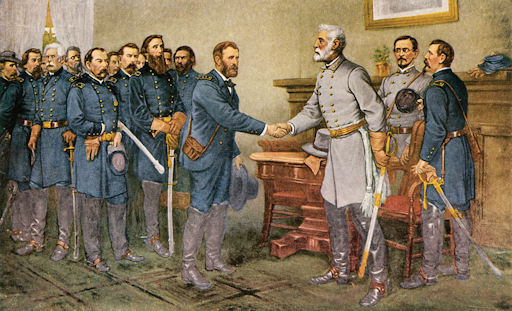 |
 Go to The Frazee Brothers in the Civil War
This page was created by Bob Frazee, Colonel, U.S. Army (Ret.)
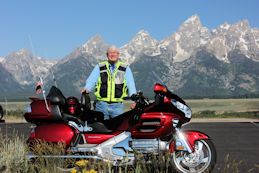
Belli at the Grand Titons, June 2015
If you have any questions, or corrections, just write to Belli.Have a good day and come back again.



(Updated: 28 March 2018) |












